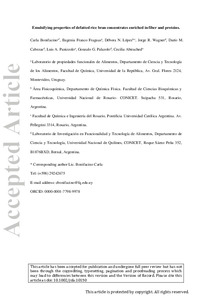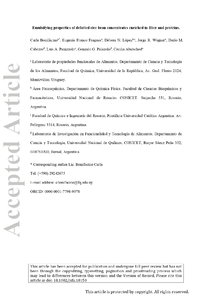Please use this identifier to cite or link to this item:
https://repositorio.uca.edu.ar/handle/123456789/9928| Título: | Emulsifying properties of defatted rice bran concentrates enriched in fiber and proteins | Autor: | Bonifacio, Carla Franco Fraguas, Eugenia López, Débora Natalia Wagner, Jorge Cabezas, Marcelo D. Panizzolo, Luis A. Palazolo, Gonzalo, G. Abirached, Cecilia |
Palabras clave: | EMULSION; ORYZA SATIVA; INGENIERIA EN ALIMENTOS; FIBRAS; SOLUBILIDAD; HIDROLISIS; ARROZ | Fecha de publicación: | 2020 | Editorial: | Wiley | Cita: | Bonifacio, C., et al. Emulsifying properties of defatted rice bran concentrates enriched in fiber and proteins [en línea]. Postprint del artículo publicado en Journal of the Science of Food and Agriculture. 2020, 100(3). doi:10.1002/jsfa.10150 Disponible en: https://repositorio.uca.edu.ar/handle/123456789/9928 | Resumen: | Abstract: BACKGROUND: Rice bran (RB), a by-product of rice milling industry, constitutes around 10% of the total weight of rough rice. The interest in the use of RB is centered on its nutritional quality, its low cost and its worldwide extensive production. As RB is commonly used for oil extraction, the defatted rice bran (DRB) is obtained as a second by-product. The aim of this work was to obtain a defatted rice bran concentrate (DRBC), enriched in protein and fiber, from defatted rice bran flour (DRBF) and to determine its physicochemical and emulsifying properties. RESULTS: To obtain the DRBC, the starch was efficiently hydrolyzed (> 98%) with α- amylase and amyloglucosidase, with the concomitant increase of crude protein (from 154.7 to 274.3 g kg-1) and total dietary fiber (from 276.1 to 492.3 g kg-1) proportions. DRBC exhibited a loss of protein solubility and increased surface hydrophobicity compared with DRBF. DRBC dispersions with and without previous ultrasound treatment were prepared. The sonication led to an increase in the apparent viscosity. Emulsions were prepared with dispersions with and without previous ultrasound treatment and showed high stability in quiescent conditions during 28 days. However, the emulsions prepared with dispersions treated with ultrasound resulted in lower D4,3 values and higher elastic and viscous moduli. CONCLUSION: The rice bran concentrate can be used to obtain stable O/W emulsions, including both fractions, soluble and insoluble, in acidic and neutral conditions. Thus, these innovative findings contribute to increase the added value of this important by-product of ricemilling industry. | URI: | https://repositorio.uca.edu.ar/handle/123456789/9928 | ISSN: | 0022-5142 (impreso) 1097-0010 (online) |
Disciplina: | INGENIERIA EN ALIMENTOS | DOI: | 10.1002/jsfa.10150 | Derechos: | Acceso abierto. 12 meses de embargo | Fuente: | Postprint del artículo publicado en Journal of the Science of Food and Agriculture. 2020, 100(3) |
| Appears in Collections: | Artículos |
Files in This Item:
| File | Description | Size | Format | |
|---|---|---|---|---|
| emulsifying-properties-defatted-rice.pdf | 486,17 kB | Adobe PDF |  View/Open | |
| emulsifying-properties-defatted-rice.jpg | 457,11 kB | JPEG |  View/Open |
Page view(s)
146
checked on Apr 30, 2024
Download(s)
383
checked on Apr 30, 2024
Google ScholarTM
Check
Altmetric
Altmetric
This item is licensed under a Creative Commons License

